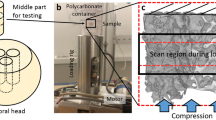Abstract
The paper presents comparison of two methods of voxel defining for trabecular bone structure modelling. Regular cubic voxels were considered, the size of which changed uniformly in three mutually perpendicular directions depending on the adopted resolution. Also elongated rectangular voxels were proposed, characterized with fixed in-plane resolution and variable length along out-of plane direction. For both types of voxels a number of analyses were performed using finite element method with structures of varied BV/TV values. It was stated that voxel dimension change in out-of plane direction allows for decreasing of a number of scans required for correct reflect of the modelled structure stiffness for the needs of numerical analyses.
Access this chapter
Tax calculation will be finalised at checkout
Purchases are for personal use only
Similar content being viewed by others
References
Topoliński, T., Cichański, A., Mazurkiewicz, A., Nowicki, K.: Microarchitecture parameters describe bone structure and its strength better than BMD. Sci. World J. 502781, 1–7 (2012). https://doi.org/10.1100/2012/502781. Article ID 502781
Depalle, B., Chapurlat, R., Walter-Le-Berre, H., Bou-Said, B., Follet, H.: Finite element dependence of stress evaluation for human trabecular bone. J. Mech. Behav. Biomed. Mater. 18, 200–212 (2013)
Ulrich, D., van Rietbergen, B., Weinans, H., Ruegsegger, P.: Finite element analysis of trabecular bone structure: a comparison of image-based meshing techniques. J. Biomech. 31(12), 1187–1192 (1998)
Boyd, S.K., Muller, R.: Smooth surface meshing for automated finite element model generation from 3D image data. J. Biomech. 39(7), 1287–1295 (2006)
Topoliński, T., Cichański, A., Mazurkiewicz, A., Nowicki, K.: The relationship between trabecular bone structure modeling methods and the elastic modulus as calculated by FEM. Sci. World J. 2012, 1–9 (2012). https://doi.org/10.1100/2012/827196. Article ID 827196
Harrison, N.M., McDonnell, P.F., OMahoney, D.C., Kennedy, O.D., OBrien, F.J., McHugh, P.E.: Heterogeneous linear elastic trabecular bone modelling using micro-CT attenuation data and experimentally measured heterogeneous tissue properties. J. Biomech. 41(11), 2589–2596 (2008)
Bardyn, T., Reyes, M., Larrea, X., Buchler, P.: Influence of Smoothing on Voxel-Based Mesh Accuracy in Micro-Finite Element. Springer, New York (2010)
Cichański, A., Nowicki, K.: Morphological dilation as the method of mineral fraction loss compensation in reconstruction of trabecular bone structure. In: Proceedings of 22nd International Conference on Engineering Mechanics 2016, pp. 114–117 (2016)
Cichański, A., Nowicki, K., Mazurkiewicz, A., Topoliński, T.: Investigation of statistical relationships between quantities describing bone architecture, its fractal dimensions and mechanical properties. Acta Bioeng. Biomech. 12(4), 69–77 (2010)
Boutroy, S., Van Rietbergen, B., Sornay-Rendu, E., Munoz, F., Bouxsein, M.L., Delmas, P.D.: Finite element analysis based on in vivo HR-pQCT images of the distal radius is associated with wrist fracture in postmenopausal women. J. Bone Miner. Res. 23(3), 392–399 (2008)
Bevill, G., Keaveny, T.M.: Trabecular bone strength predictions using finite element analysis of micro-scale images at limited spatial resolution. Bone 44(4), 579–584 (2009)
Author information
Authors and Affiliations
Corresponding author
Editor information
Editors and Affiliations
Rights and permissions
Copyright information
© 2019 Springer Nature Switzerland AG
About this paper
Cite this paper
Cichański, A., Nowicki, K. (2019). Trabecular Bone Microstructural FEM Analysis for Out-Of Plane Resolution Change. In: Arkusz, K., Będziński, R., Klekiel, T., Piszczatowski, S. (eds) Biomechanics in Medicine and Biology. BIOMECHANICS 2018. Advances in Intelligent Systems and Computing, vol 831. Springer, Cham. https://doi.org/10.1007/978-3-319-97286-2_19
Download citation
DOI: https://doi.org/10.1007/978-3-319-97286-2_19
Published:
Publisher Name: Springer, Cham
Print ISBN: 978-3-319-97285-5
Online ISBN: 978-3-319-97286-2
eBook Packages: Intelligent Technologies and RoboticsIntelligent Technologies and Robotics (R0)




